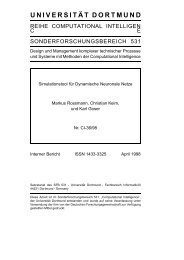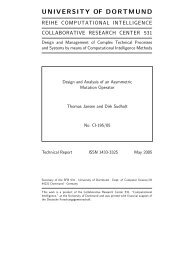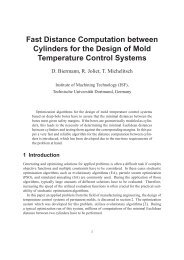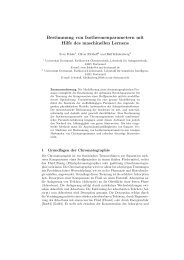Self-Adaptive Genetic Algorithms with Simulated Binary Crossover
Self-Adaptive Genetic Algorithms with Simulated Binary Crossover
Self-Adaptive Genetic Algorithms with Simulated Binary Crossover
Create successful ePaper yourself
Turn your PDF publications into a flip-book with our unique Google optimized e-Paper software.
F1-1:MinimizeNXi=1(xi?xi)2; 5.1.1 Function F1-1: Quadratic function<br />
First, we consider the sphere model, where the objective is to minimize the followingN-variable function:<br />
(17)<br />
wherexiis the optimal value of thei-th variable. In the simulations presented first, we have chosen xi=0:0. Populations are initialized inxi2[?1:0;1:0]. Real-parameter GAs <strong>with</strong> SBX are used to<br />
find the optimal solution for this function. Tournament sizes=2and distribution index=1for SBX<br />
operator are used. A population size of 100 is used. To investigate the effect of SBX operator alone, we<br />
have not used any mutation operator. The Euclidean distanceR=qPNi=1x2iof the best solution in a<br />
population from the minimum is plotted <strong>with</strong> generation number in Figure 4. The ordinate axis is drawn in<br />
Best R<br />
1<br />
1e-10<br />
(10/10,100)-ES<br />
(1,100)-ES<br />
No SA, (1,100)-ES<br />
BLX-0.5<br />
SBX<br />
1e-20<br />
0 200 400 600 800 1000<br />
Generation Number<br />
2c;:<br />
used<br />
above equation yieldsR1=0:0598.<br />
Figure 4: Population-best distanceRfrom the<br />
R1=N<br />
minimum obtained <strong>with</strong> several evolutionary algorithms on<br />
test function F1-1.<br />
logarithmic scale and the figure shows that real-parameter GAs <strong>with</strong> SBX (solid line) are able to maintain<br />
increased precision <strong>with</strong> generation number. Here, it is worth mentioning that the straight lines refer to<br />
linear convergence, that is, an exponential decrease of the residual distance to the optimum. The figure<br />
also shows the performance of several other evolutionary algorithms. ES <strong>with</strong> no self-adaptation (marked<br />
as ‘No SA’) and <strong>with</strong>=1and=100are shown next. We have used a fixed mutation strength of 0.01<br />
here. The children population size=100is to keep the number of function evaluation same as that<br />
in the real-parameter GAs. The figure re-confirms an already established (Beyer, 1996) fact that a comma<br />
ES <strong>with</strong>out self-adaptation cannot find continuously increasing precision. From a theoretical analysis on<br />
the sphere model it was found that a non-self-adaptive ES gets stuck at a distanceR1given by (Beyer,<br />
1996):<br />
For (1,100)-ES,c1;100=2:51and the An average of population-best<br />
Rvalues from generation 800 till 1000 generations is calculated from the simulation data and it is found<br />
to be0:0585, which is in good agreement (<strong>with</strong>in 2%) <strong>with</strong> the theory.<br />
9








